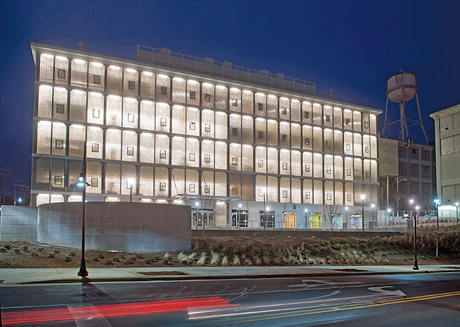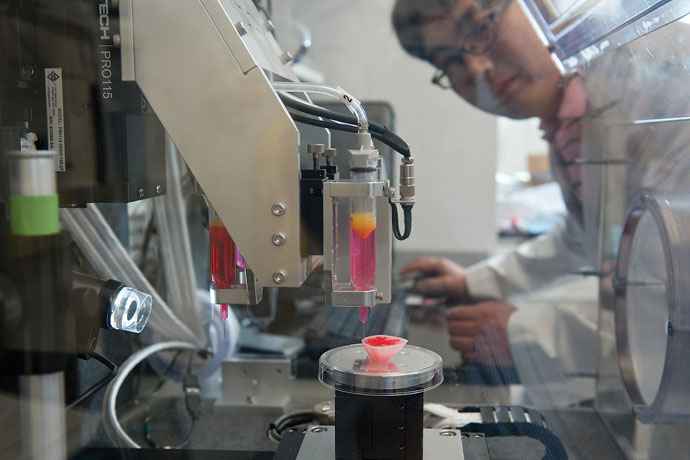If the walls of the gleaming new Wake Forest Biotech Place could talk, what would they say?
Would they speak of the buildings’ proud-but-complex history, an integral part of the tobacco industry that once was a foundation of American commerce?
Or would they speak of cutting-edge medical research that could lead to breakthrough treatments for the world’s most intractable diseases?
If they had a voice, they could speak to both. The striking glass and brick complex is part of a quiet transformation taking place in the foothills of the state’s Piedmont region, about 100 miles (160 km.) due west of the state’s flagship research hub in Raleigh-Durham.
After an 18-month, US$100-million makeover, two former R.J. Reynolds tobacco warehouses in downtown Winston-Salem re-opened in February 2012 as a 242,000-sq.-ft. (22,482-sq.-m.) state-of-the art biotech center that houses medical research departments affiliated with Wake Forest Baptist Medical Center and an incubator for fledgling biotech firms.
Financed through a combination of federal, state and local funding sources — including the federal New Market and Historic Tax Credits program, North Carolina Mill Rehabilitation Tax Credits and local tax increment financing — Biotech Place is the latest addition to the growing Piedmont Triad Research Park (PTRP), rising on a swath of long-underutilized industrial property at the intersection of US Route 52 and Interstate 40, along the southern edge of downtown.
“Biotech Place is a breathtaking new facility,” says Eric Tomlinson, a globally experienced biotech executive who was simultaneously named PTRP president and chief innovation officer of Wake Forest Baptist Medical Center in June. “Our past was tobacco and textiles. Our future is technology, and it’s all converging here at the research park.”
PTRP partnered with Baltimore-based Wexford Science Technology LLC to manage the rehabilitation process for Biotech Place.
To create the new facility, two adjacent Reynolds buildings were gutted and stripped to their skins, and retrofitted with new systems. A new glass atrium connects the two formerly separate structures. The design incorporates a cache of surplus glass bricks used in the construction of the original buildings in the 1930s that was found during the gutting process.

R.J. Reynolds has been headquartered in Winston-Salem since the company’s founding in 1874. But by the 21st century, it had moved most of its core manufacturing operations elsewhere. In 2004, Reynolds decided to donate 38 acres (15 hectares) of excess downtown real estate and $2 million in cash to help develop the research park. The $19-million contribution, which included 40 buildings, was a pure gift to the city of Winston-Salem, according to Reynolds spokesperson David Howard.
“We received a tax write-off for the donation, but beyond that there were no other incentives associated with this,” says Howard. He says that as a corporate citizen of the community, the company is committed to its revitalization. “We all live here too, and the changes taking place are really making a difference in the city,” he says. “Our donation is clearly playing a pivotal role in the redevelopment of downtown Winston-Salem.”
In 2010 Reynolds transferred to the city the final piece of property: a decommissioned coal-fired power plant that Tomlinson hopes to re-imagine as an art museum.
“We want to pattern it after London’s Tate Modern,” a modern art museum inside an old power plant on the banks of the Thames River, Tomlinson says.
Big dreams, ambitious goals
At build-out, PTRP will be the largest urban park of its kind in the U.S., Tomlinson, says. The fact that Raleigh-Durham’s Research Triangle lies just down the road doesn’t faze him. Nor do the expansion plans of other major medical centers in the Mid-Atlantic region, such as Baltimore’s Johns Hopkins University.
“When you’ve seen one research park, you’ve only seen one research park,” he says. “They are all different, and they all have a slightly different focus. PTRP is unique. It is envisioned not only as a research center, but as a place where people can live, shop and play.”
Wexford has reconfigured some of the former Reynolds buildings as loft residences, where Tomlinson himself recently moved.
“I have a three-minute commute by foot to work,” he says. “It’s a great quality of life, and we think this will appeal to many research and technology companies looking to provide this lifestyle as an added benefit to attract top talent, while leveraging Wake Forest’s research capabilities and state-of-the-art facilities.”
Inmar Stays
One home-grown technology company that had considered a major move decided instead to stay in Winston-Salem because of the park’s appeal and the opportunity to be a part of the city’s economic revival.
Faced with the prospect of outgrowing its existing space, e-commerce company Inmar knew it needed to make a move. After an extensive site search in the region and in other states, the company decided to stay, opting to renovate two donated Reynolds buildings on the PTRP campus to house its expanding work force. Wexford will manage the makeover process, making use of the same financing arrangements used with Biotech Place to enable the adaptive re-use of the visually striking and historically significant buildings.
“Because we have large facilities in Atlanta and Fort Worth, both those locations were considered,” says Rick Schmidt, Inmar’s director of finance. “Many downtown locations were considered through the process, as well as sites throughout the city and in Kernersville,” located just to the east. The company received 12 formal proposals to build out various sites. “We also had countless unsolicited inquiries.”
Schmidt attributes the company’s decision to the positive changes taking place in the city and the opportunity to be a part of the transformation. “The revitalization of downtown Winston-Salem, and in particular this site, is in alignment with Inmar’s strong belief in sustainability,” he says. “It was a cultural decision as well. Locating here means being part of a growing technology community. It offers unique and attractive amenities. It also gives us access to the additional talent that we want to attract.”
Inmar is investing $60 million in the project and creating more than 200 high-paying jobs. In exchange, the company is receiving a $7-million incentives package that includes state and local grant funding and support for workplace training. “The incentives come with claw-back provisions and performance criteria,” Schmidt notes.
As for Reynolds, the activity taking place at the research park is sparking a wave of interest in other excess real estate.
According to Howard, upscale hospitality company Quaintance-Weaver is considering the purchase of Reynolds’ historic former headquarters building for a new hotel. Designed by William F. Lamb, the architect who also designed the Empire State Building, the building was built in 1927. It’s sat empty for the last few years, after the company built its new headquarters next door.
“We are optimistic about the prospects for this,” says Howard, “which would represent a real cornerstone for the whole Winston-Salem revitalization effort.”
